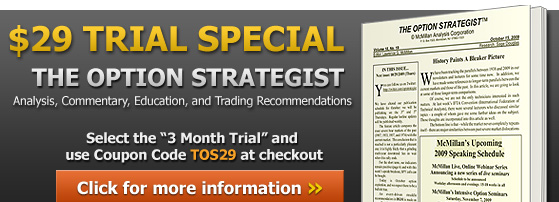
By Lawrence G. McMillan
All futures contracts are limited in the amount by which their price can change in any one day. The exchange where the future is traded determines the size of that daily limit. The greatest fear that any futures trader has is that he will get caught on the wrong side of a prolonged limit move and therefore not be able to get out of his position. If this happens, huge losses could occur. However, future options may prove to be a valuable tool when limit moves occur, either as a price discovery mechanism or as a way of confining losses. Limit moves usually occur as a result of an expected increase or decrease in the supply of a commodity -- either caused by weather (storms), cartels (OPEC), or an unexpected government report. Moreover the results of these items can be exacerbated if they occur over a (long) weekend or holiday.
Example: Suppose a major storm hits the Midwest and seriously damages the soybean crop. Just before the storm soybeans were trading at a price of 550. The daily limit is 30 cents. After the storm, a quick assessment of the crop damage is quickly translated into the soybean futures market, which opens sharply higher. However, beans can only trade up 30 cents a day. So on the first day they are quoted at 580 bid (no offer), but they don't trade because no one wants to sell soybean futures at 580. This situation is known as bid limit up. On the second day, they are quoted at 610 bid, but again they do not trade. Finally, on the third day, they again trade a little higher and begin free trading since a level has been reached where sellers enter the market. Anyone who was short soybeans would not have been able to cover his position until free trading resumed three days later, and he would have sustained large losses.
Futures options sometimes have trading limits imposed on them as well. Most of these options are on the Chicago Board of Trade (all grains, U.S. Treasury bonds, Municipal Bond Index, Nikkei stock index, etc.), although currency options on the Chicago Merc are included as well. For example, each distinct soybean option also has a maximum limit of 30 cents change in price per day. At other exchanges, options are free to trade even though futures have effectively halted because they are up or down the limit. However, even in the situations where futures options themselves have a trading limit, there may be out-of-the-money options available for trading that have not yet reached their trading limit.
Price Discovery
Where options are freely trading, one can use them to imply the price where the futures would be trading were they not at their trading limit.
Example: August Soybeans have been inflated in price due to drought fears, having closed on Friday at 650 ($6.50 per bushel). However, over the weekend it rains heavily in the Midwest, and it appears that the drought fears were overdone. Soybeans open down 30 cents -- to 620 -- down the allowable 30 cent limit. Furthermore, there are no buyers at that level and the August bean contract is locked limit down. No further trading ensues.
One may be able to use the August soybean options as a price discovery mechanism to see where August soybeans would be trading if they were open.
Suppose that the following prices exist, even though August soybeans are not trading because they are locked limit down:
| Option |
Last Sale Price
|
Net Change for the Day
|
|---|---|---|
| August 625 call |
19
|
-21
|
| August 625 put |
31
|
+16
|
An option strategist knows that synthetic long futures can be created by buying a call and selling a put, or vice versa for short futures. Knowing this, one can tell what price futures are projected to be trading at:
Implied Futures Price = Strike Price + Call Price - Put price
= 625 + 19 - 31 = 613
With these options at the prices shown, one can create a synthetic futures position at a price of 613. Therefore, the implied price for August soybean futures is 613 in this example.
In the above example, neither of the options in question had moved the 30-point limit which applies to soybean options as well as to soybean futures. If they had, they would not be useable in the formula for implying the price of the future. Only options that are freely trading -- not limit up or down -- can be used in the above formula. One may ask how the market makers are able to create markets for the options when the future is not freely trading. They are pricing the options off of cash quotes. Knowing the cash quote, they can imply the price of the future (613 in this case), and they can then make option markets as well.
Using the Options To Hedge Your Loss
The real value in being able to use the options when a future is locked limit up or limit down, of course, is to be able to hedge one's position. Simplistically, if a trader came in long the August soybean futures and they were locked limit down as in the above example, he could use the puts and calls to effectively close out his position.
Example: As before, August soybeans are at 620, locked down the limit of 30 cents. A trader has come into this trading day long the futures and he is very worried. He cannot liquidate his long position, and, if soybeans should open down the limit again tomorrow, his account will be wiped out. He can use the August options to effectively close out his position. We have mentioned many times that the following is true: Long put + short call is equivalent to short futures. So if this trader were to buy a put and short a call at the same strike, then he would have the equivalent of a short futures position to offset his long futures position. Using the following prices -- which are the same as before -- one can see how his risk is limited to the effective futures price of 613. That is, buying the put and selling the call is the same as selling his futures out at 613, down 37 cents on the trading day.
| Current Option Prices |
Last Sale Price
|
Net Change for the Day
|
|---|---|---|
| August 625 call |
19
|
-21
|
| August 625 put |
31
|
+16
|
Position:
Buy August 625 put for 19
Sell August 625 call for 31
|
Aug Futures at Expiry
|
Put Price
|
Put Pft/Loss
|
Call Price
|
Call P/L
|
Position Net Profit or Loss
|
|---|---|---|---|---|---|
|
575
|
50
|
+$1900
|
0
|
+$1900
|
+$3800
|
|
600
|
25
|
-600
|
0
|
+1900
|
+1300
|
|
613
|
12
|
-1900
|
0
|
+1900
|
0
|
|
625
|
0
|
-3100
|
0
|
+1900
|
-1200
|
|
650
|
0
|
-3100
|
25
|
-600
|
-3700
|
This column on the far right shows that selling the August 625 call at 19 and buying the August 625 put at 31 is equivalent to -- that is, it has the same profit potential as -- selling the August future at 613. Thus, in effect, one is closing out his long position by the combined action of "buying a put and selling a call."
The trader's resultant position after buying the put and selling the call would be a conversion (long futures, long put, and short call). This strategy has no further price risk or potential from this point forward, whether soybeans trade higher or lower. The margin required for a conversion or reversal is zero in the futures market. The margin rules recognize the riskless nature of such a strategy. Thus, any excess money that he has after paying for the unrealized loss in the futures will be freed up for new trades. The same or similar strategies could be used by an naked option seller who cannot hedge his position because the option is up the limit. He, too, could utilize options that are still free trading to create a synthetic futures position.
Caveat: Note that the use of this strategy does not guarantee that one will be able to avoid losses when futures make a limit move. Rather, it guarantees that one will be able to take his loss as opposed to waiting at least one more day and perhaps seeing that loss increase substantially if the commodity's cash market moves further against him.
Summary
Futures options generally have enough out-of-the-money striking prices listed that some of them will still be free trading even if the futures are up or down the limit. This fact is a boon to anyone who has a position that has moved the daily trading limit. In addition, even the trader who does not have a position can utilize the options to see where the futures would be trading were they not locked at the limit. Knowing how to use just this one futures option trading strategy should be a worthwhile benefit to any futures trader.
Originally published in The Option Strategist Newsletter Volume 2, No. 1 on January 7th, 1993.
© 2023 The Option Strategist | McMillan Analysis Corporation

